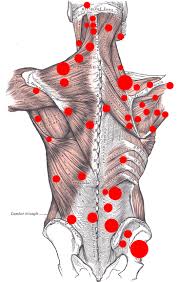Therapeutic Services
Neuromuscular Therapy
Neuromuscular Therapy (NMT) is a modern, logical system of massage therapy. It is based on understanding how the neuromuscular system functions. The nervous system controls everything in the body, including muscle tension and pain. NMT techniques often use the thumbs or fingertips to explore tissues in detail. Tense muscles often form bands of muscle fibers even tighter than the rest. These are areas of hypertonicity (excess tension in muscles) and ischemia (restriction of blood flow). Searching thoroughly, bands of tight muscle fibers are located; the areas that are in the most trouble. These are found and treated until they release This therapy has grown to include treatment of the craniosacral system, joints, connective tissues and internal organs. Problems in any body system can create high-intensity nerve impluses that stimulate muscles to contract, leading to pain.[2]
Core Bodywork
In this type of bodywork we — client and practitioner in relationship — challenge the core to soften, to release connective tissue holding patterns, and to integrate the changes into the bodymind of the client. Verbal skills from the practitioner are sometimes as important as the body work skills, as we are asking clients to examine old ways of being and see what may be appropriate to change. It is our job to stretch, realign and integrate this connective tissue into the most effective and appropriate configuration possible. A session is a very active partnership with the practitioner identifying and holding "stuck" places in the body's connective tissue webwork while the client breathes and stretches to release these holding patterns. People choose CORE bodywork for a variety of reasons including chronic or acute pain, postural difficulties, as an adjunct to other therapies, to maintain good health and flexibility, or just to help them remember to relax and breathe! Clients often report feeling opened up and expanded breath capacity and energy.[4]
MPS Therapy
MPS Therapy is an effective pain relieving method that combines concepts from:
Electrical Nerve Stimulation
Muscle Relaxation
Nerve Stimulation
Practitioners locate areas of the body that are known to treat pain. They then use a handheld unit that generates low frequency DC electrical stimulation to these areas and releases the body’s endorphins. This allows your body to naturally relieve your pain, reduce your stress levels and boost your immune system.
Here are a few of the conditions MPS Therapy is used to treat:
Muscle Spasms
Range of Motion Issues
Fibromyalgia
Chronic Back Pain
Carpal Tunnel
Repetitive Strain Injuries
Tension Headaches/Migraines

Trigger Point Therapy
Trigger points or trigger sites are described as hyperirritable spots in skeletal muscle that are associated with palpable nodules in taut bands of muscle fibers. Trigger point practitioners believe that palpable nodules are small contraction knots[ambiguous] and a common cause of pain. Compression of a trigger point may elicit local tenderness, referred pain, or local twitch response. The local twitch response is not the same as a muscle spasm. This is because a muscle spasm refers to the entire muscle entirely contracting whereas the local twitch response also refers to the entire muscle but only involves a small twitch, no contraction. The trigger point model states that unexplained pain frequently radiates from these points of local tenderness to broader areas, sometimes distant from the trigger point itself. Practitioners claim to have identified reliable referred pain patterns, allowing practitioners to associate pain in one location with trigger points elsewhere.[2]

[1] Content Copyright ProfessionalPlanets.com LLC dba MassagePlanet.com
[2] Content Obtained from Wikipedia.com.
[3] Content Obtained from cuppingtherapy.org
[4] Content Obtained from corecaregroup.com


